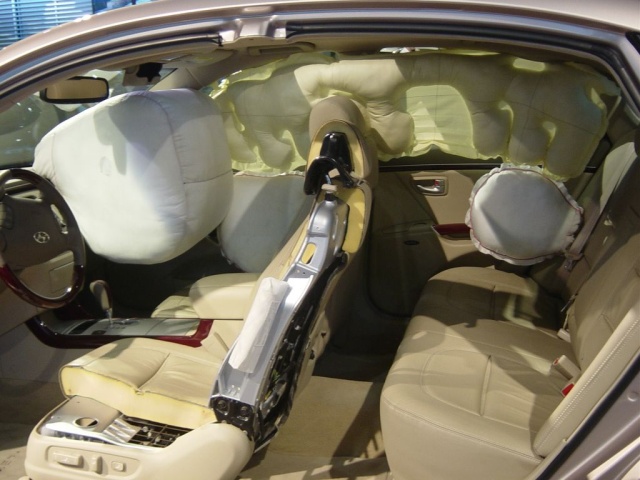 Imagine you’re in your car driving home. The weather isn’t particularly bad, the road conditions are fine, and you’re singing along with the radio. Then out of nowhere, a car makes an illegal turn, winds up in front of you, and you don’t have time to stop. You hear the screech of metal as your car collides with the other, and brace yourself to go flying through the windshield. Instead, you are pushed backward into your seat, held there for a split second, and then the pressure subsides. Your seatbelt was the first line of defense but you are upright in the driver’s seat because your car is equipped with a vehicle airbag.
Imagine you’re in your car driving home. The weather isn’t particularly bad, the road conditions are fine, and you’re singing along with the radio. Then out of nowhere, a car makes an illegal turn, winds up in front of you, and you don’t have time to stop. You hear the screech of metal as your car collides with the other, and brace yourself to go flying through the windshield. Instead, you are pushed backward into your seat, held there for a split second, and then the pressure subsides. Your seatbelt was the first line of defense but you are upright in the driver’s seat because your car is equipped with a vehicle airbag.
Twenty years ago, when vehicle airbag systems were first being offered, many people joked about how airbags worked. Some likened them to stove-top popcorn, of the type that started out looking like a pie pan and ended up looking like a lumpy silver balloon, while others thought they were just really big balloons. Either way, most people thought and many people still think that once an airbag deploys, it remains inflated leaving you cheek to cheek with talcum coated nylon until help arrives.
In reality though, how airbags work is by decreasing the momentum of the driver and passengers within a car to zero. It’s a direct relation to the old physics statement about objects in motion remaining in motion; when your car collides with another, the car stops moving but without an airbag and your seatbelt (they’re designed to work together) you would keep going forward. To make matters more difficult, this momentum must be stopped in less than a whole second and only the space between the driver and steering wheel or passenger and dashboard is available for this to happen.
How Airbags Work
There are three main components to an airbag system. They are the bag, the sensor, and the inflation system.
The Bag
Airbags are constructed from a fine gauge of nylon and then folded into the steering wheel, dashboard, the door panel or sometimes, the roof rails above the door.
The Sensor
This is the mechanism that tells the bag it’s time to inflate, which generally requires the equivalent force of running into a brick wall at 10 – 15 mph. Sensors in newer airbag systems are designed to determine whether or not there is a person in the front passenger seat and whether or not the passenger has enough weight for the bag to be safely deployed.
The Inflation System
The inflation system of an airbag is usually a combination of potassium nitrate (KNO3) and sodium azide (NaN3) which combine to form nitrogen gas. Hot discharges of this gas inflate the bag at a speed of roughly 200 mph. Immediately after inflation, the gas is dispersed through tiny holes in the airbag, which causes it to deflate. The entire process takes about 1/25 of a second. Talk about a chemistry and physics lesson rolled into one!
Cornstarch or talcum powder is generally used within the storage system for airbags to keep everything flexible and stick-proof. It also helps to ensure that the airbag will deploy properly.
Airbags were originally designed to be used as a seatbelt replacement system. Ford actually produced cars with an early version of the technology in the 1970s but the modern version of the bags didn’t come into wide use until the late 1980s. It wasn’t until the mid-1990s that at least two airbags were standard in most cars.
No longer marketed to replace seatbelts, it is now understood that airbags work in tandem with safety belts to keep drivers and passengers inside a car, and in an upright position, during a collision. The use of a seatbelt however is still the most important aspect of automobile safety.
Other safety features related to vehicle airbags are as follows:
1. The ideal distance is 10 inches between your breastbone and an airbag. Smaller distances can cause impact injuries when the bag is first inflated.
2. Smaller adults (under 5′ 4″) and children may be safer riding in cars with the passenger seat airbags switched off, in order to avoid injuries to the face and neck during a collision.
3. Children in backward-facing infant seats should never be placed in a front seat with the airbag engaged; their heads are too close to the bag.
Modern vehicle airbags are much safer than the originals from the 80s and 90s, and now do more than just protect passengers from front-impact collisions. Current systems include special protection for the head and neck, and some will help cushion and restrain the driver and passengers if the vehicle should roll over.
Source: Topspeedracer
